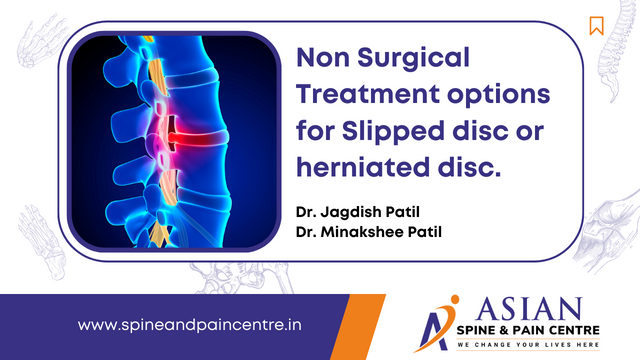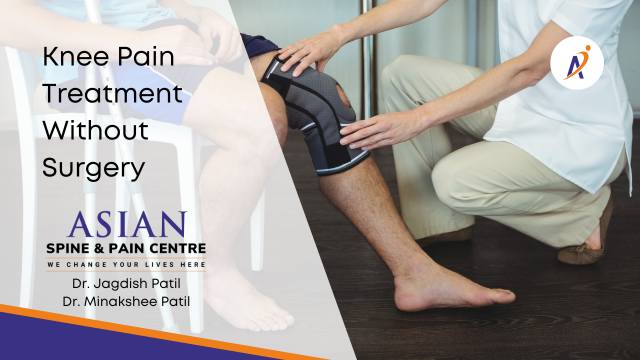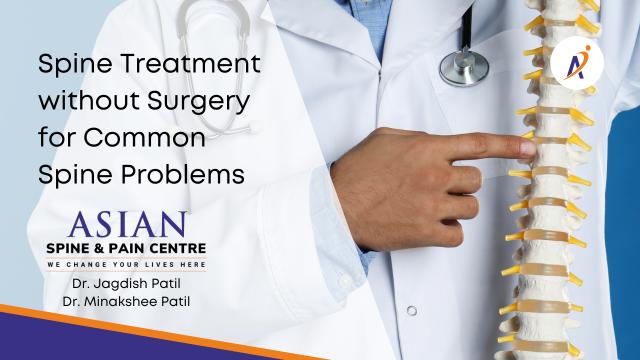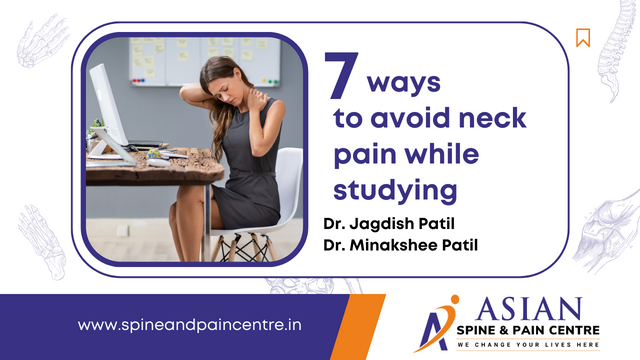Non-Surgical Treatments For Slip Disc
What are non-surgical treatment options for slipped disc?
Slipped disc can be cured without surgery.
Yes, we can treat slipped disc or herniated disc without any surgery with most advanced techniques at Asian Spine & Pain Centre in Pune. This mainly involves exercise, relaxation and positioning, painkillers or local anesthetics, and manual and physical therapy, spinal injections & radiofrequency ablation.
What is slipped disc?
The human spine is made up of vertebrae (bones) that are piled on top of one another. The cervical spine has seven bones, the thoracic spine has twelve, and the lumbar spine has five, with the sacrum and coccyx at the base. A disc exists between each pair of bones and serves as a stress absorber during daily actions such as walking, lifting, and twisting.
Each disc is made up of two parts: a soft, gelatinous interior and a strong outer ring. A slipped disc occurs when the inner portion of the disc protrudes through the outer ring. It is also referred to as a herniated or prolapsed disc. It causes discomfort and pain. If a slipped disc compresses a spinal nerve, you may have numbness and discomfort along the damaged nerve. In severe cases, surgery may be required to remove or repair the slipped disc. People between the ages of 30 and 50 are most likely to have a slipped disc. It affects females more than males.
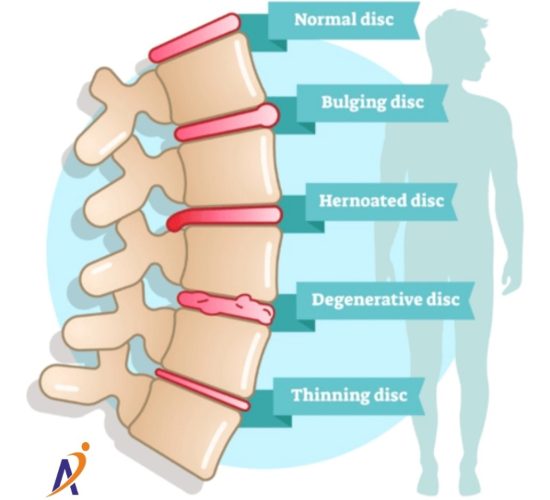
What makes a slipped disc worse?
The pain from a herniated disc usually is worse when you are active and gets better when you are resting. Coughing, sneezing, sitting, driving, and bending forward may make the pain worse. The pain gets worse when you make these movements because there is more pressure on the nerve.
What are the signs of slipped disc or herniated disc?
Pain and numbness, most commonly on one side of the body. Pain that extends to your arms or legs. Pain that worsens at night or with certain movements. Pain that worsens after standing or sitting. Pain when walking short distances. Unexplained muscle weakness. Tingling, aching, or burning sensations in the affected area.
Which exercises to avoid in slipped disc?
Skip movements that involve significant axial loading on the lower back, such as squats and leg presses. Avoid toe-touches, sit-ups, and yoga poses that worsen the pain and lead to significant bending of the back.
Is slipped disc for life?
It takes to heal often between six and eight weeks. Additionally, patients with this condition often heal just fine without surgery. The good news is that in most cases — 90% of the time — pain caused by a herniated disc will go away permanently within six months after treatment.
What are the treatment options of slipped disc or herniated disc?
Most people with a slipped disc in the lumbar region of their spine (lower back) are offered “conservative” treatment, meaning that the treatment does not involve surgery. This mainly involves exercise, relaxation and positioning, painkillers or local anesthetics, and manual and physical therapy.
Medication for the pain: non-steroidal anti-inflammatory drugs (NSAIDs), Opioids, Steroids, Muscle relaxants etc.
Massages: Various massage techniques are used to relax muscles and ease tension.
Heating and cooling: This include the use of hot packs and heating patches, a hot bath, going to the sauna or using an infrared lamp. Heat can also help relax tense muscles. Cold packs, like cold wraps or gel packs, are also used to help soothe irritated nerves.
Ultrasound therapy: Here the lower back is treated with sound waves. The small vibrations that are produced generate heat and relax the body tissue.
Spinal Injections: In lumbar spinal nerve analgesia, the medication is injected directly at the point where the nerve root leaves the spinal canal. This has a numbing effect on the nerve root. In lumbar epidural analgesia, the medication is injected into what is known as the epidural space (“epidural injection”). The epidural space surrounds the spinal cord and the spinal fluid in the spinal canal. This is also where the nerve roots are located. During this treatment the spine is monitored using computer tomography or x-rays to make sure that the injection is placed at exactly the right spot.
Radio frequency Ablation: Radio frequency ablation (RFA) is a technique used to reduce pain. In this procedure, a radio wave produces an electrical current, which heats up a small area of nerve tissue.
It is particularly important to stay as physically active as possible despite the pain. Exercise will not only keep your body in shape, it generally also has a positive effect on your mood. Getting enough exercise and keeping up the strength of your torso (core muscles) is key in order to stop back pain from becoming chronic. Physical activity has been scientifically proven to have a preventive effect – and it is probably the most important thing you can do to help yourself.
At Asian Spine & Pain Centre, Dr. Jagdish Patill & Dr. Minakshee Patill will help you overcome pain due to slipped disc without any surgery, by using most advanced treatment options available in India.
Asian Spine & Pain Centre
We change your lives here!
Asian
Spine And Pain Centre
Asian Spine And Pain Centre
We change your lives here!
Dr. Jagdish Patill
M.B.B.S., M.S.(Orth), FIIPM, FIMISS
Endoscopic Spine & Joint Replacement Surgeon
Pain management Expert
Dr. Minakshee Patill
M.B.B.S., M.D., FPCI, FIPM
Interventional Pain Management Expert
Latest articles
Dr. Jagdish Patil & Dr. Minakshee Patil provides spine treatment without Surgery for common spine problems like spinal stenosis, herniated disc, sciatica, arthritis in Pune.
Dr. Jagdish Patil & Dr. Minakshee Patil provides spine treatment without Surgery for common spine problems like spinal stenosis, herniated disc, sciatica, arthritis in Pune.
Follow these 7 simple steps suggested by best pain management expert, Dr. Jagdish Patil, to avoid neck pain while studying long hours.
“World Class Super Speciality Centre for Spine, Joints, Pain & Regenerative Therapies”
Let's Connect
+91-7218113113
Main Clinic
304, 3rd Floor, Choice ‘C’ Apartment, Opp. Millennium Star building, Near Ruby Hall Clinic, Pune 411001.
Send A Mail
Our facilities
Physiotherapy
Procedure Room
Pharmacy
X-ray & Imaging room
Emergency Care
Online Consultancy
FAQs:
Yes, in more than 90% cases with chronic knee pain, a noninvasive or minimal invasive procedures can be used to avoid surgeries. But in 10% cases, surgery is unavoidable and can provide long term benefit. So trust our experts at Asian Spine & pain Centre to provide accurate diagnosis and pain management treatment for your chronic knee pain.
The goal / aim of sports medicine is to maintain, sustain, and at times to regain peak physical fitness i.e., adaptability to stress, physical and mental. Main functions of sports medicine are promotive, educative, formative, recreative, competitive, therapeutic and rehabilitative in nature. At Asian Spine & Pain Centre, we provide complete care of sport sports injuries for athletes in Pune.
Yes, in most cases, physiotherapy is must to regain complete joint mobility and muscular strength. It can be required after any orthopedic treatment either surgical or non-surgical. At Asian Spine & pain Centre, we have a tea, of experienced physiotherapists to provide complete care.
You might have serious back problem or emergency for which you need immediate orthopedic care. Following signs can help you to identify these serious situations – Sharp pain rather than a dull ache, Radiating pain, Sudden weakness in the legs, incontinence, numbness or needle like pain in the groin.
Yes. X-rays are often a good tool for determining if arthritis exists and, specifically, what type. Common types of arthritis include rheumatoid arthritis, psoriatic arthritis, and osteoarthritis. Early in the disease process, more sophisticated imaging may be necessary, especially MRI. We do provide X-ray imaging services at Asian Spine & Pain Centre.
If you’re experiencing chronic pain, a doctor may recommend that you have a nerve block, a temporary or permanent procedure that disrupts specific nerve activity. It can help diagnose or treat certain types of neuropathic pain, or pain caused by nerve dysfunction or damage. At Asian Spine & pain centre, we use nerve block therapy in selected cases of chronic pain.
As is often the case, recovery time can vary from person to person depending on the location of the surgery, the type of surgery required and the lifestyle of the patient. However, most patients are able to leave the hospital the same day and are typically able to return to their active lives within 4-6 weeks after surgery. However, some are back to normal in 1-2 weeks.
You shouldn’t downhill ski or play contact sports such as football and soccer. In general, avoid sports that require jerking, twisting, pulling, or running. You should be able to do lower-impact activities, such as hiking, gardening, swimming, playing tennis, and golfing.
Arthroscopy is a procedure for diagnosing and treating joint problems. A surgeon inserts a narrow tube attached to a fiber-optic video camera through a small incision — about the size of a buttonhole. The view inside your joint is transmitted to a high-definition video monitor. Arthroscopy allows the surgeon to see inside your joint without making a large incision. Surgeons can even repair some types of joint damage during arthroscopy, with pencil-thin surgical instruments inserted through additional small incisions.

